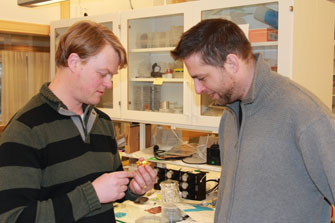Fighting Childhood Cancer with a Nanotech Capsule Therapy
Researchers from KTH’s Microsystem Technology Lab are working with colleagues at Karolinska Hospital to develop and test a nanotechnology capsule for precise delivery of stem cell medicine. The aim is to fight the most common type of childhood cancer—without the unpleasant side effects of traditional chemotherapy.

Chemotherapy is among the most important treatments available to doctors treating cancer patients. But chemo comes with sometimes severe side effects, including hair loss, nausea and fatigue. And chemotherapy suppresses normal immune system function, making patients — especially children — susceptible to infections.
“We’ve identified a much better and more effective way to treat cancer tumours with fewer side effects, largely thanks to our new more robust, repeatable and controllable manufacturing process,” says Wouter van der Wijngaart, Professor of Microsystem Technology at KTH.
Professor van der Wijngaart and research colleague Tommy Haraldsson are working on a porous plastic cage made from polymeric materials featuring tiny holes whose size is measured in nanometers, or billionths of a meter. Stem cells, genetically modified to produce toxins that attack rapidly dividing cancer cells, are encapsulated in the cage and sent to do their work directly on the tumour.
The patient is given a “prodrug” that is inactive when introduced into the patient’s body, but begins to excrete chemically active toxins as it is metabolised by the stem cells. Most chemotherapy treatments available today affect the patient systemically, while the new delivery system is intended to produce extremely focussed results. Once the medication has performed its intended function, it will break down into harmless components and be eliminated from the body.
“This new chemotherapy method produces the cell-killing effect inside the tumour itself, which means we don’t have to subject the patient to large doses spread throughout body,” says van der Wijngaart.

The capsule protects the body from the potential negative side effects from the stem cell treatment, and at the same time prevents the patient’s immune defences from attacking what would normally be treated as unwelcome foreign cells.
Previous testing by Karolinska Hospital researcher Matthias Löhr on pancreatic tumours shows that the method dramatically increases patient survival rates under the right conditions.
“The downside of this treatment is that the body’s immune system can attack the polymer plastic cages,” explains van der Wijngaart. “Also, there is a risk that the stem cells that are designed to stop the spread of the tumour may themselves cause new tumours to develop. The function of the capsule is extremely important, and the manufacturing process has to be extremely precise.”
The KTH and Karolinska Hospital researchers are now working with paediatric cancer researcher John Inge Johnsen at the Karolinska Institute to test the new method on medulloblastomas (highly malignant brain tumours) and neuroblastomas (among the most common childhood cancers). These cancer types normally respond poorly to treatment and mortality rates are high.
The capsule will be manufactured in a new process at KTH with a “lab on a chip” — a chemical laboratory on a microchip — which makes the process more controllable. The researchers have also improved the polymer, and the entire package can be tested before it’s introduced to the patient’s body.
Karolinska Hospital supplies the stem cells for encapsulation and introduction into the body. The capsules are about as thick as a human hair, with from one hundred to a few thousand stem cells contained in each capsule.
In addition to the chemotherapy capsule, KTH researchers are working on four other projects in the fight against childhood cancer. Five of the seven projects recently receiving funding from Sweden’s Childhood Cancer Foundation will be led by KTH. Each project will receive a total of SEK 1.3 million ($185,000).
For more information: Wouter van der Wijngaart, +46-73-325-4021; wouter@kth.se.
By Marie Androv

